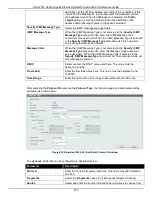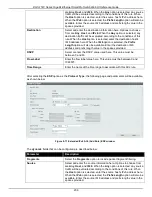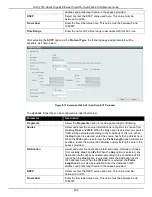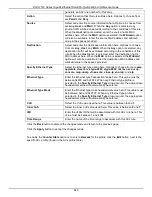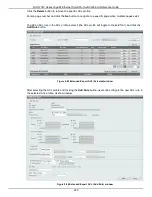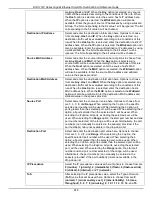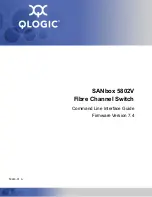
DGS-1510 Series Gigabit Ethernet SmartPro Switch Web UI Reference Guide
248
are
Any
,
Host
, and
IP
. When the
Any
option is selected, any source
traffic will be evaluated according to the conditions of this rule. When
the
Host
option is selected, enter the source host’s IP address here.
When the
IP
option is selected, the
Wildcard
option will also be
available. Enter the group of source IP addresses by using a wildcard
bitmap. The bit corresponding to the bit value 1 will be ignored. The bit
corresponding to the bit value 0 will be checked.
Destination IP Address
Select and enter the destination information here. Options to choose
from are
Any
,
Host
, and
IP
. When the
Any
option is selected, any
destination traffic will be evaluated according to the conditions of this
rule. When the
Host
option is selected, enter the destination host’s IP
address here. When the
IP
option is selected, the
Wildcard
option will
also be available. Enter the group of destination IP addresses by using
a wildcard bitmap. The bit corresponding to the bit value 1 will be
ignored. The bit corresponding to the bit value 0 will be checked.
Source MAC Address
Select and enter the source information here. Options to choose from
are
Any
,
Host
, and
MAC
. When the
Any
option is selected, any
source traffic will be evaluated according to the conditions of this rule.
When the
Host
option is selected, enter the source host’s MAC
address here. When the
MAC
option is selected, the
Wildcard
option
will also be available. Enter the source MAC address and wildcard
value in the spaces provided.
Destination MAC Address
Select and enter the destination information here. Options to choose
from are
Any
,
Host
, and
MAC
. When the
Any
option is selected, any
destination traffic will be evaluated according to the conditions of this
rule. When the
Host
option is selected, enter the destination host’s
MAC address here. When the
MAC
option is selected, the
Wildcard
option will also be available. Enter the destination MAC address and
wildcard value in the spaces provided.
Source Port
Select and enter the source port value here. Options to choose from
are
=
,
>
,
<
,
≠
, and
Range
. When selecting the
=
option, the specific
selected port number will be used. When selecting the
>
option, all
ports greater than the selected port, will be used. When selecting the
<
option, all ports smaller than the selected port, will be used. When
selecting the
≠
option, all ports, excluding the selected port, will be
used. When selecting the
Range
option, the start port number and end
port number selected, of the range, will be used. Alternatively, the port
number(s) can manually be entered in the space(s) provided, if the
port number(s) is/are not available in the drop-down list.
Destination Port
Select and enter the destination port value here. Options to choose
from are
=
,
>
,
<
,
≠
, and
Range
. When selecting the
=
option, the
specific selected port number will be used. When selecting the
>
option, all ports greater than the selected port, will be used. When
selecting the
<
option, all ports smaller than the selected port, will be
used. When selecting the
≠
option, all ports, excluding the selected
port, will be used. When selecting the
Range
option, the start port
number and end port number selected, of the range, will be used.
Alternatively, the port number(s) can manually be entered in the
space(s) provided, if the port number(s) is/are not available in the
drop-down list.
IP Precedence
Select the IP precedence value used here. Options to choose from are
0 (routine)
,
1 (priority)
,
2, (immediate)
,
3 (flash)
,
4 (flash-override)
,
5 (critical)
,
6 (internet)
, and
7 (network)
.
ToS
After selecting the IP precedence value, select the Type-of-Service
(
ToS
) value that will be used here. Options to choose from are
0
(normal)
,
1 (min-monetary-cost)
,
2 (max-reliability)
,
3
,
4 (max-
throughput)
,
5
,
6
,
7
,
8 (min-delay)
,
9
,
10
,
11
,
12
,
13
,
14
, and
15
.
Summary of Contents for DGS-1510 Series
Page 1: ...1...


